Lesson2 Beijing Opera教案
- 格式:docx
- 大小:13.14 KB
- 文档页数:4

北师大版(2019)必修第三册Unit 7 ArtLesson 2 Beijing Opera本节课的教材分析:本节课的教材来源于北师大版(2019)必修第三册Unit 7 Art Lesson 2 Beijing Opera。
该教材通过对京剧的介绍,让学生了解到京剧作为中国特色的传统艺术形式,具有丰富的文化内涵和艺术特点。
教材主要包括了文本、听力、阅读、语法等方面的内容,以及配套的图片和练习题,能够帮助学生更全面、系统地了解京剧。
教学目标:1. 知识与能力目标:学生能够掌握和运用相关的词汇、短语和句型,了解京剧的起源、发展和特点。
2. 过程与方法目标:培养学生的听、说、读、写、翻译等综合语言运用能力,提高学生的跨文化交际能力。
3. 情感与态度目标:培养学生对传统文化的兴趣与热爱,增强对中国传统文化的自豪感与归属感。
教学重点:1. 了解京剧的起源、发展和特点。
2. 学习相关的词汇、短语和句型,能够运用于实际交际中。
3. 培养学生对京剧的兴趣和热爱。
教学难点:1. 学生对京剧的了解较少,对课文中的一些文化背景和专业术语理解困难。
2. 如何通过课堂教学提高学生的综合语言运用能力。
学情分析:学生层次:高一学生,具备一定的英语基础和跨文化交际能力。
学生特点:对传统文化和艺术形式有一定的兴趣,但对京剧的了解可能较有限。
教学资源:教材提供的课文和配套的图片、练习题等。
教学策略:1. 激发学生学习兴趣,利用多媒体资源展示京剧的艺术特点和演出片段,让学生有更直观的了解。
2. 引导学生主动参与学习,通过小组讨论、角色扮演等方式,提高学生的口语表达和跨文化交际能力。
3. 注重任务型教学,设置情境和任务,让学生在实际语境中运用所学知识,提高学习的实用性和有效性。
教学方法:1. 情景教学法:通过展示京剧的实际演出和相关的图片,让学生身临其境,感受京剧的魅力和独特性。
2. 讨论式教学法:通过小组讨论,鼓励学生思考和交流,促进学生的互动和合作。
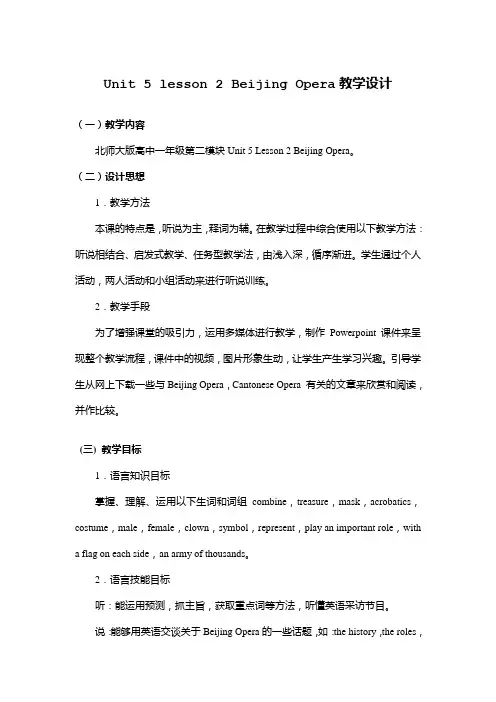
Unit 5 lesson 2 Beijing Opera教学设计(一)教学内容北师大版高中一年级第二模块Unit 5 Lesson 2 Beijing Opera。
(二)设计思想1.教学方法本课的特点是,听说为主,释词为辅。
在教学过程中综合使用以下教学方法:听说相结合、启发式教学、任务型教学法,由浅入深,循序渐进。
学生通过个人活动,两人活动和小组活动来进行听说训练。
2.教学手段为了增强课堂的吸引力,运用多媒体进行教学,制作Powerpoint课件来呈现整个教学流程,课件中的视频,图片形象生动,让学生产生学习兴趣。
引导学生从网上下载一些与Beijing Opera,Cantonese Opera 有关的文章来欣赏和阅读,并作比较。
(三) 教学目标1.语言知识目标掌握、理解、运用以下生词和词组combine,treasure,mask,acrobatics,costume,male,female,clown,symbol,represent,play an important role,with a flag on each side,an army of thousands。
2.语言技能目标听:能运用预测,抓主旨,获取重点词等方法,听懂英语采访节目。
说:能够用英语交谈关于Beijing Opera的一些话题,如:the history,the roles,the skills needed,the singing styles,the costumes 等读:课后能去收集,读懂有关Beijing Opera和Cantonese Opera的中英文章,并能说出两者的异同。
写:能用150个左右的单词写出一篇Beijing Opera英语介绍。
3.情感态度目标通过对Beijing Opera的教学,增强学生对中国文化瑰宝的了解和热爱;让学生体验用英语交流的成功与喜悦;培养他们的合作精神、互助精神。
4.学习策略目标这堂课的学习策略主要有:在听前,利用已有的知识来预测答案;在听的过程中,抓住关键词获取主旨大意;听完之后,把所获取的信息进行交谈和写作。
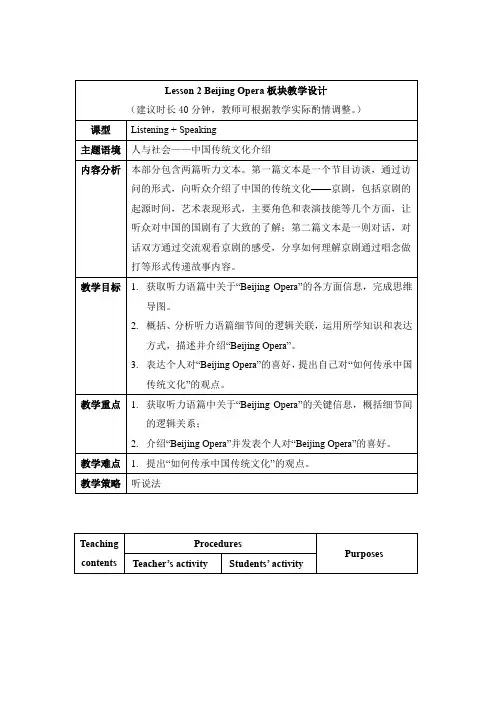
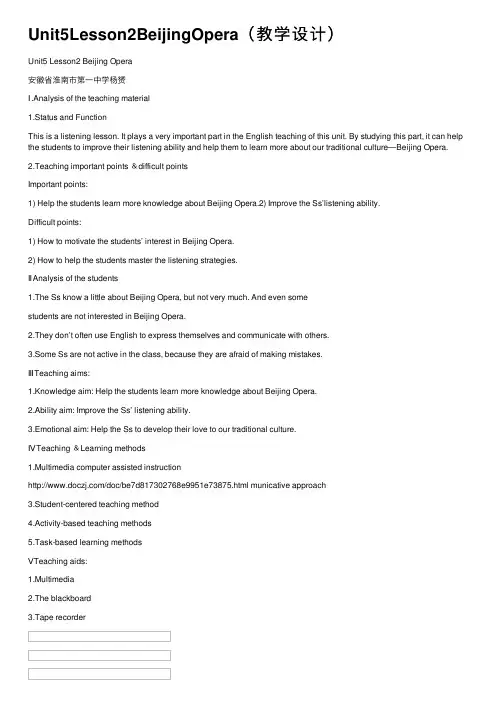
Unit5Lesson2BeijingOpera(教学设计)Unit5 Lesson2 Beijing Opera安徽省淮南市第⼀中学杨赟Ⅰ.Analysis of the teaching material1.Status and FunctionThis is a listening lesson. It plays a very important part in the English teaching of this unit. By studying this part, it can help the students to improve their listening ability and help them to learn more about our traditional culture—Beijing Opera. 2.Teaching important points ﹠difficult pointsImportant points:1) Help the students learn more knowledge about Beijing Opera.2) Improve the Ss’listening ability.Difficult points:1) How to motivate the students’ interest in Beijing Opera.2) How to help the students master the listening strategies.ⅡAnalysis of the students1.The Ss know a little about Beijing Opera, but not very much. And even somestudents are not interested in Beijing Opera.2.They don’t often use English to express themselves and communicate with others.3.Some Ss are not active in the class, because they are afraid of making mistakes.ⅢTeaching aims:1.Knowledge aim: Help the students learn more knowledge about Beijing Opera.2.Ability aim: Improve the Ss’ listening ability.3.Emotional aim: Help the Ss to develop their love to our traditional culture.ⅣTeaching ﹠Learning methods1.Multimedia computer assisted instruction/doc/be7d817302768e9951e73875.html municative approach3.Student-centered teaching method4.Activity-based teaching methods5.Task-based learning methodsⅤTeaching aids:1.Multimedia2.The blackboard3.Tape recorderⅦ Blackboard designUnit5 Lesson2 Beijing OperaHistory Main rolesMain instrumentsBeijing Opera Symbols SkillsSinging styles Costumes。
![[精品K12]Lesson2 Beijing Opera学习型教学案](https://uimg.taocdn.com/8479053aba1aa8114431d9e6.webp)
Lesson2 Beijing Opera学案Lesson2Beijingopera学案一、学习目标【话题】1.熟悉了解主要英语国家的艺术形式。
2.了解中外著名画家、艺术家、建筑师,以及不同的艺术、建筑风格。
【词汇】instrument,male,female,general,combine,inotherwords 【交际用语】学习请求允许或拒绝的用语※Isitok/allrightifI…?can/couldI…? woulditbeallrightifIdid…?Pleaseletme….No,I'mafrai dyoucan't.二、知识要点1.suchas与forexamplesuchas为短语介词用法,表列举与上文所说事物有相似点的事物,意“象…那样的”,后直接加名词、代词,不与andsoon连用。
如:childrensuchasthesemakepeoplecheerful.象这样的孩子们会使人们欢喜。
IvisitedseveralEuropeancountries,suchasFrance,Italy andGermany.forexample“例如”,用来举例子,可以放在所举例子的前面,也可放在所举例子的后面,常用逗号隔开。
wevisitedseveralEuropeancountries,forexample,France ,ItalyandGermany.(也可说成……France,ItalyandGermany,forexample.)此外,forexample 还可用来引出一句话或一件事来举例说明上文内容,如:Tomisakindperson.Forexample,heoftenoffersmoneytopoo rpeople.2.well,symbolsplayaveryimportantroleinBeijingopera.一些动作在京剧中起着非常重要的作用。
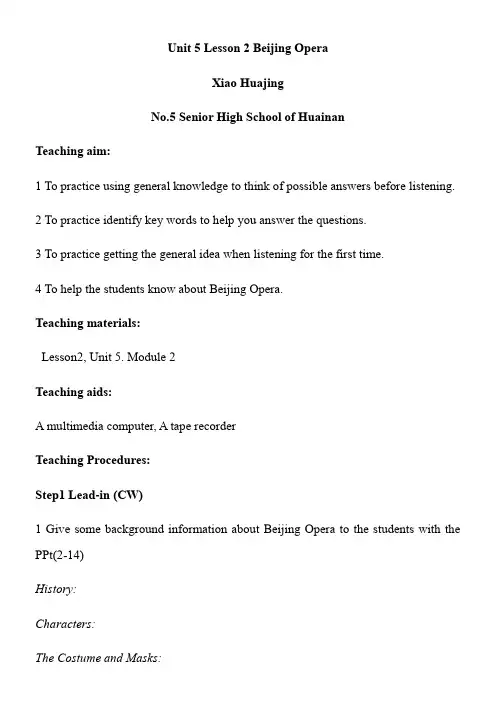
Unit 5 Lesson 2 Beijing OperaXiao HuajingNo.5 Senior High School of HuainanTeaching aim:1 To practice using general knowledge to think of possible answers before listening.2 To practice identify key words to help you answer the questions.3 To practice getting the general idea when listening for the first time.4 To help the students know about Beijing Opera.Teaching materials:Lesson2, Unit 5. Module 2Teaching aids:A multimedia computer, A tape recorderTeaching Procedures:Step1 Lead-in (CW)1 Give some background information about Beijing Opera to the students with the PPt(2-14)History:Characters:The Costume and Masks:Instruments:Four Main Roles:2 Brief Introduction of Mei Lanfang.(ppt15)Step 2 Listening Strategies〔CW, ppt16〕Present the listening strategies to the student with the help of ppt16. Help the students to understand.Step 3 Listening Practice I(IW,pp17)Task1: Listen to the tape carefully and complete the sentences with key words.The art started in the late 18th century and it combines ________, ________, ________, music, ________ and ________.In the early days, Beijing Opera was most often performed on __________ in __________, __________, __________ or __________. The music had to be played __________ and the performers had to sing with ______________, in order to be heard over the crowd.Beijing Opera was often performed on open-air stages and stages were lit by oil lamp. If the costume weren’t in ____________, the crowds wouldn’t be able to ____________.Step4 Listening Practice II(IW,ppt18)Task 2: Listen and use the strategies to answer the questions listed on the screen. Questions:1 What skills do Beijing Opera actors need to have?2 Where was Beijing Opera performed at the beginning?3 Why does it have very loud music and sharp singing style?4 Why do performers wear brightly coloured costume?Step5 Listening PracticeIII (IW,ppt19)Task 3: Students read and listen to the last part of the program. Then answer the questions below:1 What does the stage like in Beijing Opera?2 How do symbols pay an important role in Beijing Opera?Step6 Summary(IW,ppt22-23)Guide the students do a summary by finishing the information chart:Step 7 Speaking:(PW.ppt24)Students practice in pairs to have a talk about Beijing Opera with the help of the Summary.Step 8 Homework:Write a short composition about Beijing Opera.。
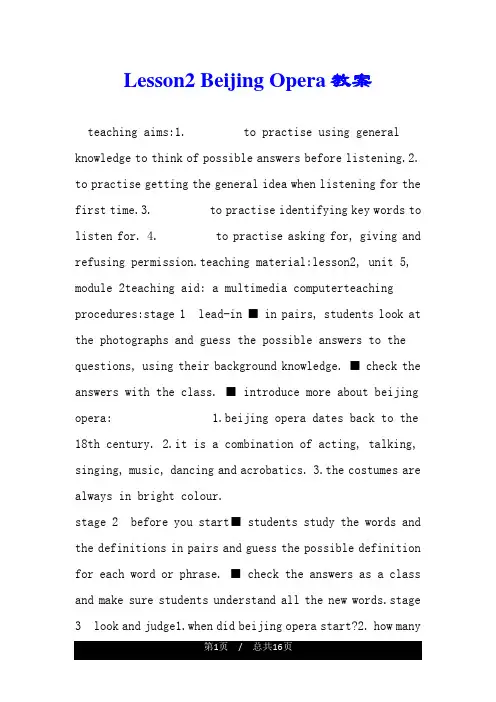
Lesson2 Beijing Opera教案teaching aims:1. to practise using generalknowledge to think of possible answers before listening.2. to practise getting the general idea when listening for thefirst time.3. to practise identifying key words tolisten for. 4. to practise asking for, giving and refusing permission.teaching material:lesson2, unit 5,module 2teaching aid: a multimedia computerteaching procedures:stage 1 lead-in ■ in pairs, students look atthe photographs and guess the possible answers to the questions, using their background knowledge. ■ check the answers with the class. ■ introduce more about beijingopera: 1.beijing opera dates back to the18th century. 2.it is a combination of acting, talking, singing, music, dancing and acrobatics. 3.the costumes arealways in bright colour. stage 2 before you start■ students study the words andthe definitions in pairs and guess the possible definitionfor each word or phrase. ■ check the answers as a classand make sure students understand all the new words.stage3 look and judge1.when did beijing opera start?2. how manymain roles are there in beijing opera?3. what are the main instruments played in it?4. match the main roles with their names: sheng male roles with brightly paintedfaces dan female roles jingclown roleschou male rolesstage 4 find out the definition■ students study the words and the definitionsin pairs and guess the possible definition for each wordor phrase. ■ check the answers as a class and make sure students understand all the new words.step 5 listeningusethe strategies :listen & answer the questions.1.whatskills do beijing opera actors need to have?2019--05teaching aims:1. to practise using generalknowledge to think of possible answers before listening.2. to practise getting the general idea when listening for thefirst time.3. to practise identifying key words tolisten for. 4. to practise asking for, giving and refusing permission.teaching material:lesson2, unit 5,module 2teaching aid: a multimedia computerteaching procedures:stage 1 lead-in ■ in pairs, students look atthe photographs and guess the possible answers to thequestions, using their background knowledge. ■ check the answers with the class. ■ introduce more about beijing opera: 1.beijing opera dates back to the18th century. 2.it is a combination of acting, talking, singing, music, dancing and acrobatics. 3.the costumes are always in bright colour. stage 2 before you start■ students study the words andthe definitions in pairs and guess the possible definitionfor each word or phrase. ■ check the a nswers as a classand make sure students understand all the new words.stage3 look and judge1.when did beijing opera start?2. how many main roles are there in beijing opera?3. what are the main instruments played in it?4. match the main roles with their names: sheng male roles with brightly painted faces dan female roles jing clown roleschou male rolesstage4 find out the definition■ students study the words and the definitionsin pairs and guess the possible definition for each wordor phrase. ■ check the answers as a class and make sure students understand all the new words.step 5 listeningusethe strategies :listen & answer the questions.1.whatskills do beijing opera actors need to have?2019--05teaching aims:1. to practise using generalknowledge to think of possible answers before listening.2. to practise getting the general idea when listening for thefirst time.3. to practise identifying key words tolisten for. 4. to practise asking for, giving and refusing permission.teaching material:lesson2, unit 5,module 2teaching aid: a multimedia computerteaching procedures:stage 1 lead-in ■ in pairs, students look atthe photographs and guess the possible answers to the questions, using their background knowledge. ■ check the answers with the class. ■ introduce more about beijingopera: 1.beijing opera dates back to the18th century. 2.it is a combination of acting, talking, singing, music, dancing and acrobatics. 3.the costumes arealways in bright colour. stage 2 before you start■ students study the words andthe definitions in pairs and guess the possible definitionfor each word or phrase. ■ check the answers as a c lassand make sure students understand all the new words.stage3 look and judge1.when did beijing opera start?2. how manymain roles are there in beijing opera?3. what are the main instruments played in it?4. match the main roles with their names: sheng male roles with brightly paintedfaces dan female roles jingclown roleschou male rolesstage 4 find out the definition■ students study the words and the definitionsin pairs and guess the possible definition for each wordor phrase. ■ check the answers as a class and make sure students understand all the new words.step 5 listeningusethe strategies :listen & answer the questions.1.whatskills do beijing opera actors need to have?2019--05teaching aims:1. to practise using generalknowledge to think of possible answers before listening.2. to practise getting the general idea when listening for thefirst time.3. to practise identifying key words tolisten for. 4. to practise asking for, giving and refusing permission.teaching material:lesson2, unit 5,module 2teaching aid: a multimedia computerteaching procedures:stage 1 lead-in ■ in pairs, students look atthe photographs and guess the possible answers to thequestions, using their background knowledge. ■ check the answers with the class. ■ introduce more about beijing opera: 1.beijing opera dates back to the18th century. 2.it is a combination of acting, talking, singing, music, dancing and acrobatics. 3.the costumes are always in bright colour. stage 2 before you start■ students study the words andthe definitions in pairs and guess the possible definitionfor each word or phrase. ■ check the answers as a classand make sure students understand all the new words.stage3 look and judge1.when did beijing opera start?2. how many main roles are there in beijing opera?3. what are the main instruments played in it?4. match the main roles with their names: sheng male roles with brightly painted faces dan female roles jing clown roleschou male rolesstage4 find out the definition■ students study the words and the definitionsin pairs and guess the possible definition for each wordor phrase. ■ check the answers as a class and make sure students understand all the new words.step 5 listeningusethe strategies :listen & answer the questions.1.whatskills do beijing opera actors need to have?2019--05teaching aims:1. to practise using generalknowledge to think of possible answers before listening.2. to practise getting the general idea when listening for thefirst time.3. to practise identifying key words tolisten for. 4. to practise asking for, giving and refusing permission.teaching material:lesson2, unit 5,module 2teaching aid: a multimedia computerteaching procedures:stage 1 lead-in ■ in pairs, students look atthe photographs and guess the possible answers to the questions, using their b ackground knowledge. ■ check the answers with the class. ■ introduce more about beijingopera: 1.beijing opera dates back to the18th century. 2.it is a combination of acting, talking, singing, music, dancing and acrobatics. 3.the costumes arealways in bright colour. stage 2 before you start■ students study the words andthe definitions in pairs and guess the possible definitionfor each word or phrase. ■ check the answers as a classand make sure students understand all the new words.stage3 look and judge1.when did beijing opera start?2. how manymain roles are there in beijing opera?3. what are the main instruments played in it?4. match the main roles with their names: sheng male roles with brightly paintedfaces dan female roles jingclown roleschou male rolesstage 4 find out the definition■ students study the words and the definitionsin pairs and guess the possible definition for each wordor phrase. ■ check the answers as a class and make sure students understand all the new words.step 5 listeningusethe strategies :listen & answer the questions.1.whatskills do beijing opera actors need to have?2019--05teaching aims:1. to practise using generalknowledge to think of possible answers before listening.2. to practise getting the general idea when listening for thefirst time.3. to practise identifying key words tolisten for. 4. to practise asking for, giving and refusing permission.teaching material:lesson2, unit 5,module 2teaching aid: a multimedia computerteaching procedures:stage 1 lead-in ■ in pairs, students look atthe photographs and guess the possible answers to thequestions, using their background kno wledge. ■ check the answers with the class. ■ introduce more about beijing opera: 1.beijing opera dates back to the18th century. 2.it is a combination of acting, talking, singing, music, dancing and acrobatics. 3.the costumes are always in bright colour. stage 2 before you start■ students study the words andthe definitions in pairs and guess the possible definitionfor each word or phrase. ■ check the answers as a classand make sure students understand all the new words.stage3 look and judge1.when did beijing opera start?2. how many main roles are there in beijing opera?3. what are the main instruments played in it?4. match the main roles with their names: sheng male roles with brightly painted faces dan female roles jing clown roleschou male rolesstage4 find out the definition■ students study the words and the definitionsin pairs and guess the possible definition for each wordor phrase. ■ check the answers as a class and make sure students understand all the new words.step 5 listeningusethe strategies :listen & answer the questions.1.whatskills do beijing opera actors need to have?2019--05teaching aims:1. to practise using generalknowledge to think of possible answers before listening.2. to practise getting the general idea when listening for thefirst time.3. to practise identifying key words tolisten for. 4. to practise asking for, giving and refusing permission.teaching material:lesson2, unit 5,module 2teaching aid: a multimedia computerteaching procedures:stage 1 lead-in ■ in pairs, students look atthe photographs and guess the possible answers to the questions, using their background knowledge. ■ che ck the answers with the class. ■ introduce more about beijingopera: 1.beijing opera dates back to the18th century. 2.it is a combination of acting, talking, singing, music, dancing and acrobatics. 3.the costumes arealways in bright colour. stage 2 before you start■ students study the words andthe definitions in pairs and guess the possible definitionfor each word or phrase. ■ check the answers as a classand make sure students understand all the new words.stage3 look and judge1.when did beijing opera start?2. how manymain roles are there in beijing opera?3. what are the main instruments played in it?4. match the main roles with their names: sheng male roles with brightly paintedfaces dan female roles jingclown roleschou male rolesstage 4 find out the definition■ students study the words and the definitionsin pairs and guess the possible definition for each wordor phrase. ■ check the answers as a class and make sure students understand all the new words.step 5 listeningusethe strategies :listen & answer the questions.1.whatskills do beijing opera actors need to have?2019--05teaching aims:1. to practise using generalknowledge to think of possible answers before listening.2. to practise getting the general idea when listening for thefirst time.3. to practise identifying key words tolisten for. 4. to practise asking for, giving and refusing permission.teaching material:lesson2, unit 5,module 2teaching aid: a multimedia computerteaching procedures:stage 1 lead-in ■ in pairs, students look atthe photographs and guess the possible answers to thequestions, using their background knowledge. ■ check the answer s with the class. ■ introduce more about beijing opera: 1.beijing opera dates back to the18th century. 2.it is a combination of acting, talking, singing, music, dancing and acrobatics. 3.the costumes are always in bright colour. stage 2 before you start■ students study the words andthe definitions in pairs and guess the possible definitionfor each word or phrase. ■ check the answers as a classand make sure students understand all the new words.stage3 look and judge1.when did beijing opera start?2. how many main roles are there in beijing opera?3. what are the main instruments played in it?4. match the main roles with their names: sheng male roles with brightly painted faces dan female roles jing clown roleschou male rolesstage4 find out the definition■ students study the words and the definitionsin pairs and guess the possible definition for each wordor phrase. ■ check the answers as a class and ma ke sure students understand all the new words.step 5 listeningusethe strategies :listen & answer the questions.1.whatskills do beijing opera actors need to have?2019--05teaching aims:1. to practise using generalknowledge to think of possible answers before listening.2. to practise getting the general idea when listening for thefirst time.3. to practise identifying key words tolisten for. 4. to practise asking for, giving and refusing permission.teaching material:lesson2, unit 5,module 2teaching aid: a multimedia computerteaching procedures:stage 1 lead-in ■ in pairs, students look atthe photographs and guess the possible answers to the questions, using their background knowledge. ■ check the answers with the cl ass. ■ introduce more about beijingopera: 1.beijing opera dates back to the18th century. 2.it is a combination of acting, talking, singing, music, dancing and acrobatics. 3.the costumes arealways in bright colour. stage 2 before you start■ students study the words andthe definitions in pairs and guess the possible definitionfor each word or phrase. ■ check the answers as a classand make sure students understand all the new words.stage3 look and judge1.when did beijing opera start?2. how manymain roles are there in beijing opera?3. what are the main instruments played in it?4. match the main roles with their names: sheng male roles with brightly paintedfaces dan female roles jingclown roleschou male rolesstage 4 find out the definition■ students study the words and the definitionsin pairs and guess the possible definition for each wordor phrase. ■ check the answers as a class and make sure students understand all the new words.step 5 listeningusethe strategies :listen & answer the questions.1.whatskills do beijing opera actors need to have?2019--05teaching aims:1. to practise using generalknowledge to think of possible answers before listening.2. to practise getting the general idea when listening for thefirst time.3. to practise identifying key words tolisten for. 4. to practise asking for, giving and refusing permission.teaching material:lesson2, unit 5,module 2teaching aid: a multimedia computerteaching procedures:stage 1 lead-in ■ in pairs, students look atthe photographs and guess the possible answers to thequestions, using their background knowledge. ■ check the answers with the class. ■ introd uce more about beijing opera: 1.beijing opera dates back to the18th century. 2.it is a combination of acting, talking, singing, music, dancing and acrobatics. 3.the costumes are always in bright colour. s tage 2 before you start■ students study the words andthe definitions in pairs and guess the possible definitionfor each word or phrase. ■ check the answers as a classand make sure students understand all the new words.stage3 look and judge1.when did beijing opera start?2. how many main roles are there in beijing opera?3. what are the main instruments played in it?4. match the main roles with their names: sheng male roles with brightly painted faces dan female roles jing clown roleschou male rolesstage4 find out the definition■ students study the words and the definitionsin pairs and guess the possible definition for each wordor phrase. ■ check the answers as a class and make sure students understand all the new words.step 5 listeningusethe strategies :listen & answer the questions.1.whatskills do beijing opera actors need to have?。
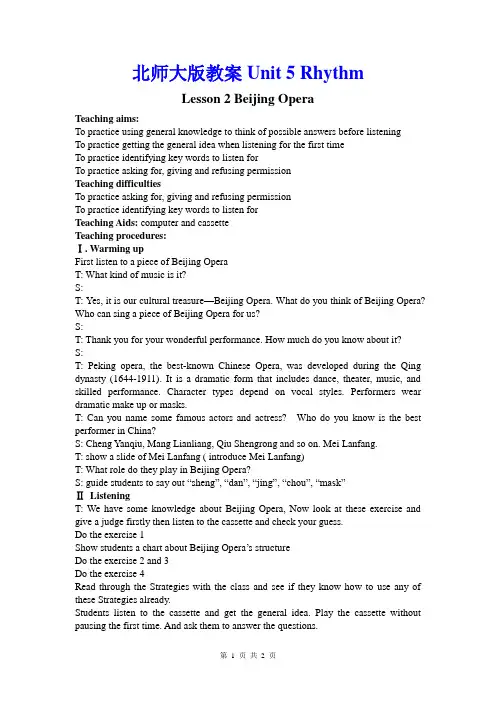
北师大版教案Unit 5 RhythmLesson 2 Beijing OperaTeaching aims:To practice using general knowledge to think of possible answers before listeningTo practice getting the general idea when listening for the first timeTo practice identifying key words to listen forTo practice asking for, giving and refusing permissionTeaching difficultiesTo practice asking for, giving and refusing permissionTo practice identifying key words to listen forTeaching Aids: computer and cassetteTeaching procedures:Ⅰ. W arming upFirst listen to a piece of Beijing OperaT: What kind of music is it?S:T: Y es, it is our cultural treasure—Beijing Opera. What do you think of Beijing Opera? Who can sing a piece of Beijing Opera for us?S:T: Thank you for your wonderful performance. How much do you know about it?S:T: Peking opera, the best-known Chinese Opera, was developed during the Qing dynasty (1644-1911). It is a dramatic form that includes dance, theater, music, and skilled performance. Character types depend on vocal styles. Performers wear dramatic make up or masks.T: Can you name some famous actors and actress? Who do you know is the best performer in China?S: Cheng Y anqiu, Mang Lianliang, Qiu Shengrong and so on. Mei Lanfang.T: show a slide of Mei Lanfang ( introduce Mei Lanfang)T: What role do they play in Beijing Opera?S: guide students to say out “sheng”, “dan”, “jing”, “chou”, “mask”ⅡListeningT: We have some knowledge about Beijing Opera, Now look at these exercise and give a judge firstly then listen to the cassette and check your guess.Do the exercise 1Show students a chart about Beijing Opera’s structureDo the exercise 2 and 3Do the exercise 4Read through the Strategies with the class and see if they know how to use any of these Strategies already.Students listen to the cassette and get the general idea. Play the cassette without pausing the first time. And ask them to answer the questions.Do the exercise 5, 6 and 7The teacher can draw a conclusion:Besides Beijing Opera, there are still other National Treasures in China. They serve as a window of China. And through this window, foreigners are able to understand Chinese culture better.ⅢSpeakingDo the exercise 8.Imagine you have to ask for permission in the situations below. Think of good reasons.Practice your oral EnglishSuppose Smith come from America. He is interested in Beijing Opera. As his interpreter you are introduce Beijing Opera to him. .Do the exercise 9ⅣWritingWrite a composition to introduce Beijing Opera its history and value,including Characters, scenes, costumes and skills needed. You can add some details, such as some names of play and famous artists.。

Unit 5 Lesson 2 Beijing OperaTeaching Objectives:1.Knowledge Objective1. To listen to and understand the listening materials.2. Students can learn something more about Beijing Opera.3. Students can grasp the new words and useful expressions.2.Ability Objective1. Enable students to catch some listening skills.2. Develop students’ ability to grasp information and take notes while listening.3. Students can describe Beijing Opera in English.3.Emotional Objective1. Enable students to know more about Beijing Opera and its value.2. Develop students’ sense of appreciating traditional culture and loving our country more.Teaching Key:Enable the students learn more about Beijing Opera and develop their listening abilities.Difficult Points:Motivate students’ interest in Beijing Opera.Enable students to practice some listening skills while listening.Teaching MethodsTask-based learning method; Situational learning method ; communicative method. Teaching ProceduresStep 1 Lead-in1.Play a short video about Beijing Opera and ask the students to answer what it is.2.Encourage the students to talk about what they know about Beijing Opera, some famous plays and roles.Step 2 Pre-listening3. Give a brief introduction of Beijing Opera and introduce some new expressions. Deal with the new expressions by matching and make sure students know how to pronounce the new words.1. Tell students they will listen to a dialogue about Beijing Opera and make them predict what the listening text is about according to the questions asked before.Step 3 While-listening1.Listen to first part of ‘What’s Your Rhythm’ to get some background knowledge about Beijing Opera.2.(pair-work)Use a diagram to generalize topics mentioned in the first listening material.e strategies to guide the listening of the second piece of listening materials.1).(group-work)Make prediction before listening.2). (pair-work)Take down key words during the first listening.3). Finish the listening practice during the second listening.4. (group-work)Retell with the help of the diagram.Step 4 Post-listening1.Give 2-3 minutes to students to ask questions if they have any.2.Get the students to conclude the listening skills learned just before.3. Show students the listening text and let them read it aloud.4. Let students read aloud the questions and expressions on the blackboard and make sure they will understand and enable to use them.Step 5 Homework1. Surf the internet to find out more information about Beijing Opera.2. Work in team to prepare a dialogue between a volunteer and a foreigner who is very interested in Beijing Opera. Try to use what we learn today as much as possible and act out their dialogue next class(there will be reward for the best team).。
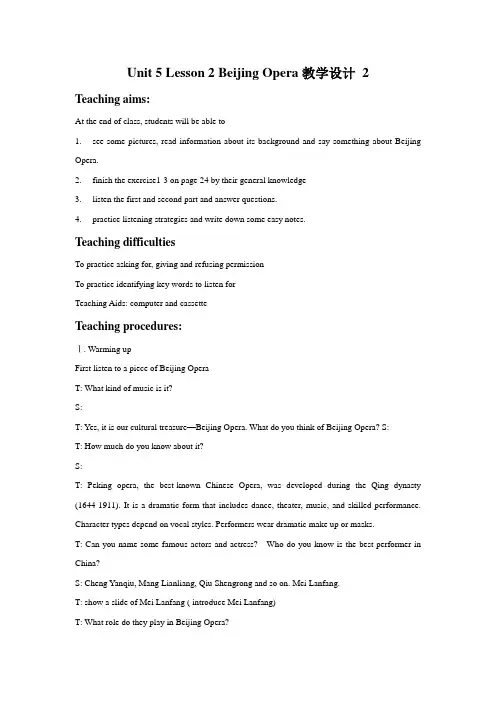
Unit 5 Lesson 2 Beijing Opera教学设计2 Teaching aims:At the end of class, students will be able to1. see some pictures, read information about its background and say something about Beijing Opera.2. finish the exercise1-3 on page 24 by their general knowledge3. listen the first and second part and answer questions.4. practice listening strategies and write down some easy notes.Teaching difficultiesTo practice asking for, giving and refusing permissionTo practice identifying key words to listen forTeaching Aids: computer and cassetteTeaching procedures:Ⅰ. Warming upFirst listen to a piece of Beijing OperaT: What kind of music is it?S:T: Yes, it is our cultural treasure—Beijing Opera. What do you think of Beijing Opera? S:T: How much do you know about it?S:T: Peking opera, the best-known Chinese Opera, was developed during the Qing dynasty (1644-1911). It is a dramatic form that includes dance, theater, music, and skilled performance. Character types depend on vocal styles. Performers wear dramatic make up or masks.T: Can you name some famous actors and actress? Who do you know is the best performer in China?S: Cheng Yanqiu, Mang Lianliang, Qiu Shengrong and so on. Mei Lanfang.T: show a slide of Mei Lanfang ( introduce Mei Lanfang)T: What role do they play in Beijing Opera?S: guide students to say out “sheng”, “dan”, “jing”, “chou”, “mask”ⅡListeningT: We have some knowledge about Beijing Opera, Now look at these exercise and give a judge firstly then listen to the cassette and check your guess.Do the exercise 1Show students a chart about Beijing Opera’s structureDo the exercise 2 and 3Do the exercise 4Read through the Strategies with the class and see if they know how to use any of these Strategies already.Students listen to the cassette and get the general idea. Play the cassette without pausing the first time. And ask them to answer the questions.Do the exercise 5, 6 and 7The teacher can draw a conclusion:Besides Beijing Opera, there are still other National Treasures in China. They serve as a window of China. And through this window, foreigners are able to understand Chinese culture better.ⅢSpeakingDo the exercise 8.Imagine you have to ask for permission in the situations below. Think of good reasons.Practice your oral EnglishSuppose Smith come from America. He is interested in Beijing Opera. As his interpreter you are introduce Beijing Opera to him. .Do the exercise 9ⅣWritingWrite a short passage to introduce Beijing Opera its history and value,including Characters, scenes, costumes and skills needed. You can add some details, such as some names of play and famous artists.。
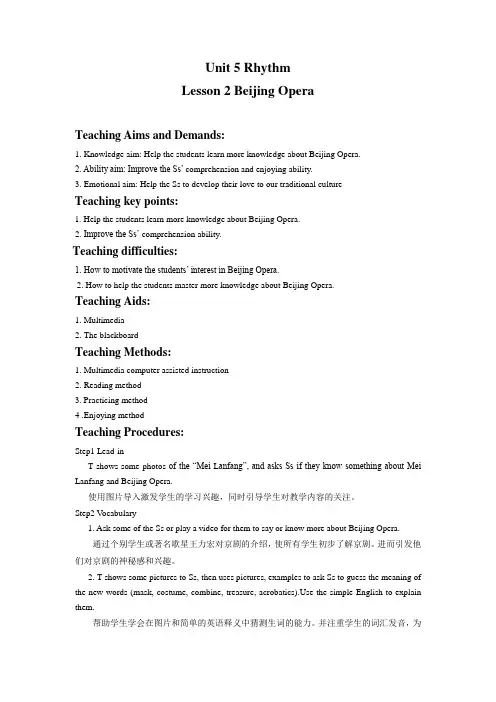
Unit 5 RhythmLesson 2 Beijing OperaTeaching Aims and Demands:1. Knowledge aim: Help the students learn more knowledge about Beijing Opera.2. Ability aim: Improve the Ss’ comprehension and enjoying ability.3. Emotional aim: Help the Ss to develop their love to our traditional cultureTeaching key points:1. Help the students learn more knowledge about Beijing Opera.2. Improve the Ss’ comprehension ability.Teaching difficulties:1. How to motivate the students’ interest in Beijing Opera.2. How to help the students master more knowledge about Beijing Opera.Teaching Aids:1. Multimedia2. The blackboardTeaching Methods:1. Multimedia computer assisted instruction2. Reading method3. Practicing method4 .Enjoying methodTeaching Procedures:Step1 Lead-inT shows some photos of the “Mei L anfang”, and asks Ss if they know something about Mei Lanfang and Beijing Opera.使用图片导入激发学生的学习兴趣,同时引导学生对教学内容的关注。
本单元属于“人与社会”主题语境下的“文学、艺术与体育”子主题。
单元主题大观念为“感受艺术魅力,赏析艺术精神,享受艺术人生。
”单元语言大观念为“运用与艺术相关的词汇和表达方式,多角度、多维度地赏析艺术形式,评析艺术精神,表达个人观点并呼吁参与艺术活动。
”本课是第七单元的听说课,话题围绕国粹京剧展开,学生通过了解京剧的基本信息和特色,学会欣赏京剧,多角度感受国粹京剧魅力,增强文化自信。
通过Lesson 1 Masterpieces(西方绘画名作)和本课L esson 2 Beijing Opera(京剧)的学习,在语言小观念1“围绕艺术形式整合性学习相关词汇和表达方式”的辅助下,学生将逐步形成单元主题小观念,即“赏析古今中外的艺术盛宴”。
本课包含两个听力语篇,第一个听力语篇介绍了京剧的主要相关信息,第二个听力语篇围绕观赏京剧后的感受展开,重点关注情感的多样表达方式。
因此,教师分别围绕两个听力语篇进行了两个课时的教学设计。
[What]第一个听力语篇主要介绍了京剧的历史,主要角色,表现形式,唱腔和音乐特点以及服饰特点。
该语篇详细阐述了京剧唱腔和京剧中音乐的独特之处(high voices and loud music)以及服饰特点(bright and colourful patterns),并联系古代京剧的表演背景解释其成因,如露天舞台(openair stages),昏暗的灯光(oil lamps)等。
[How]第一个听力语篇是一个电台节目。
专家从上述五个方面向听众介绍了京剧,并重点解释了京剧声音和服饰特色的成因。
该听力文本注重训练学生对于语篇逻辑关系的理解,使用了一些表达因果关系的功能用语,如含有表语从句的“that is why...”和“thisis because...”,以及不定式短语“in order to be heard”,从而提升了学生的逻辑思维,有助于学生逻辑清晰地表达自己的观点。
第1课时教学过程
教学目标1 学习活动效果评价预计
时间
获取梳理京剧的基本知识。
Step 1: Activate and share
T shows the four main roles of Beijing Opera and
guide Ss to tell the topic of this lesson: Beijing
Opera.
T creates a situation: Some British high school
students came to our school. They visited the
Beijing Opera club and they wanted to know more
about Beijing Opera from you.
What do you know about Beijing Opera?
学生能够根
据图片说出
本课主题
“Beijing
Opera”
2’
设计意图:
【驱动】激活学生在“京剧”这一主题的背景知识,通过创设真实情境问题,学生认识到自己在内容和语言上的双重不足,激发学生学习兴趣。
Step 2: T shows some pictures and some words that
Ss are unfamiliar with. T guides Ss to match the
words with the pictures.
Ss read after T together.
学生能够读
出生词,并
根据图片猜
出生词含
义,将图片
和单词进行
匹配
3’。
教学设计课题名称:Unit 5 Lesson 2 Beijing Opera姓名:管建刚工作单位:巢湖第四中学学科年级:高一教材版本:北师大版一、教学内容分析(简要说明课题来源、学习内容、知识结构图以及学习内容的重要性)This is a listening lesson.It plays a very important part in the English teaching of this unit.by starting this part,it can help the students to improve the listening ability and help them to learn more about our traditional cultureBeijing operaBy the end of this lesson, Ss will be able to1. Knowledge Objectives:(1) learn some new words about Beijing Opera: combine, treasure, mask, acrobatics, costume(2) learn some knowledge about Beijing Opera2. Ability Objectives:(1) learn to use listening strategies in doing listening exercises.(2) learn to use English to introduce Beijing Opera3.Emotion Objectives(1) broaden their minds by knowing something about Beijing Opera(2) introduce Beijing Opera and spread our national treasure三、学习者特征分析(学生对预备知识的掌握了解情况,学生在新课的学习方法的掌握情况,如何设计预习)1. The students know a little about Beijing opera but not very much and even some students are not interested in Beijing Opera2.They don't often use English to express themselves and communicate with others3.some students are not active in the class because they are afraid of making mistakes教师活动预设学生活动设计意图T plays a song for students and introduces the topic: Beijing OperaAs usual, the class will be divided into 5 groups. They will have a competition in this classStep1 Warm up热身并导入本课话题。
Teaching Plan for Beijing Opera班碧兰1)语言知识:单词:理解、内化、运用以下生词: dateback;combination;courtyard;piercing;costume;acrobatics;a national treasure扫除听读障碍.语法:复习和运用定语从句用于描述人、物及事件。
2)语言技能:听:听懂关于京剧的采访细节。
说:能根据听力材料提炼关于京剧的主要特点。
通过与粤剧对比,说出共同点及不同点。
读:阅读关于粤剧的材料。
写:能运用图表的指引写一篇关于京剧的短文。
3)学习策略:培养学生猜测及写关键词的听力策略。
一定程度形成自主学习,有效交际、信息处理、英语思维能力。
4)情感态度:培养祖国意识及国际视野。
体验用英语交流的成功与喜悦,以及培养合作精神、互助精神。
1.Pre- task1)Lead in the topic by playing several kinds of music including Beijing Opera. Make sure the studentsnotice the importance to get some knowledge about Beijing Opera.2)The teacher gives a brief introduction of Beijing Opera to give some new expressions a context.3)The students match the new expressions with their definitions and make sure they know how topronounce the words.2.Task- cycleTask 1: The students listen to section 1 of the listening material ‘What’s Your Rhythm’ and answer four questions.Task 2: With the help of the questions they have answered, the students try to generalize what aspects haveTask 3: The students make use of the listening strategies to guide their listening of section 2.a)To make a prediction before listening.b)To take down key words during the first listening.c)To finish the listening practice during the second listening.Task 4: The students continue to finish the diagram by summing up what have beenTask 5: The students try to retell with the help of the diagram.Task 6: Send out a written passage about Cantonese Opera. After reading and groupdiscussion, the students are to compare the two operas and find out the similarities and differences.3.Post- task1)Highlight the topic about the National Treasure and encourage the students to spend time getting someknowledge about something that is really Chinese.2)HomeworkSurf the Internet for more information about Beijing Opera and we will share it in the next period.。
Lesson2 Beijing Opera教案teaching aims:1.to practise using general knowledge to think of possible answers before listening.2.to practise getting the general idea when listening for the first time.3.to practise identifying key words to listenfor.4.to practise asking for, giving and refusing permission.teaching material:lesson2, unit 5, module 2teaching aid: a multimedia computerteaching procedures:stage 1 lead-in ■in pairs, students look at the photographs and guess the possible answers to the questions, using their background knowledge.■check the answers with the class.■introduce more about beijing opera: 1.beijing opera dates back to the 18th century.2.it is a combination of acting, talking, singing, music, dancing and acrobatics.3.the costumes are always in bright colour.stage 2 before you start■students study thewords and the definitions in pairs and guess the possible definition for each word or phrase.■check the answers as a class and make sure students understand all the new words.stage 3 look and judge1.when did beijing opera start?2.how many main roles are there in beijing opera?3.what are the main instruments played in it?4.match the main roles with their names: sheng male roles with brightly painted faces dan female roles jing clown roleschou male rolesstage 4 find out the definition■students study the words and the definitions in pairs and guess the possible definition for each word or phrase.■check the answers as a class and make sure students understand all the new words.step 5 listeninguse the strategies :listen answer the questions.1.what skills do beijing opera actors need to have?2.where was beijing opera performed at the beginning?3.why does it have very loud music and a piercing singing style?4.why do performers wearbrightly coloured costumes?step 6 tapescriptstage 7 readingread the last part of the programme and answer the questions:1.what does the stage look like in beijing opera?2.how do symbols play an important role in beijing opera?stage 8 useful expressionsstage 9 listening■students listen to the dialogue and make notes about li ming and zhu meiling.■play the dialogue two or three times if necessary.■students can compare answers in pairs before checking answers as a class.step 10 function filestep 11 summarystage 12 assignment have you ever seen any shows? write a passage to describe one unforgettable show you have ever seen.。
2021学年度北师大版新教材必修三Unit7 ArtLesson 2 Beijing Opera教学设计【教学目标】Students will be able to1. read and talk about Beijing Opera2. listen for understanding3. recall information previously heard4. express and discuss emotions【教学重难点】1. talking about Beijing Opera2. expressing and discussing emotions【教学过程】1. Talk about Beijing Opera(1) Ask the students if they have watched Beijing Opera and what their experiences were. Write these examples on the board.(2) Discuss the questions as a class. Ensure that all students get a chance to answer the questions.(3) Instruct students to work independently and match the photos with the descriptions.(4) Discuss the answers as a class.2. Listen and tick.(1) Ask a volunteer student to read the four aspects. Explain any unknown terms.(2) Instruct students to tick the aspects that are mentioned as they listen to the radio programme.3. Listen again and answer questions.(1) Explain to students that they will listen to the radio programme once more, and this time to listen for details.(2) Preview the questions with the students.(3) Suggest that students underline or take notes as they listen.(4) Students work independently or in pairs to answer the questions in full sentences.(5) Check answers as a class. If needed, replay the radio programme and point out the different features of Beijing Opera.4. Listen again, take notes, and answer questions.(1) Read aloud the instruction and the Skill Builder. Then read each question. Explain any difficult words.(2) In pairs, students discuss the answers.(3) While the radio programme is playing, students check and complete their answers.(4) Discuss the answers as a class.5. Listen again. List key phrases and talk about whether you like Beijing Opera.(1) In pairs, students listen and take notes of the key phrases used by Dr. Liu to give reasons.(2) Review the answers as a class.(3) Create a class discussion on the students’ opinion of Beijing Opera. Each student needs to provide their opinion and support with logical reasoning.6. Introduce Beijing Opera.(1) Divide students into five groups. Each group discusses one of the topics in relation to Beijing Opera: the four roles, costumes and masks, sound and singing, history and interesting features.(2) Each group selects one person to be the scribe and write down notes for the group.(3) Each student in the group describes the chosen topic. The scribe can mind map this information.(4) Each group writes a few complete sentences about their topic on Beijing Opera using these descriptions.(5) A volunteer from the group reads this passage to the class, role playing that he or she is introducing Beijing Opera to a group of foreign students.(6) The class can ask questions about the topic and members from the group can help to answer the questions.7. Listen and answer.(1) Read the instruction and questions aloud to the students.(2) Play the dialogue.(3) In pairs, students answer the questions in full sentences.(4) If needed, play the dialogue a second time. Give the students time to complete the answers.(5) Discuss the answers as a class.8. Listen, imitate, and talk about emotions.(1) Read aloud the instruction and the Talk Builder box as a class. Explain any unknown terms.(2) Ask students to give a personal example of an emotion, either satisfaction, worry or regret.a. What do these emotions mean?b. Which are positive emotions and which are negative emotions?c. How can your facial features or tone of voice show these emotions?Students can use their dictionaries, if needed.(3) Tell students that they will listen to the dialogue for more detail.(4) As students listen to the dialogue, they need to identify the emotion for each sentence in the brackets.(5) Review the answers as a class.9. Pair Work: Act it out.(1) Explain to students that they will be watching a short local opera. Students need to take notes of the roles, costumes and masks, sound and singing, history and interesting features. Play only some parts of the prepared video, either from TV or from online resources.(2) Divide the class into pairs. Tell students that they will role play a dialogue between a Chinese student and a foreign student.(3) Student A is role playing a Chinese student, who understands the different elements of opera. Student B is role playing a foreign student, who does not understand opera and asks questions.(4) In pairs, students first write down five questions that a foreign student would ask about the opera; then students provide responses in a script format.(5) Students can practise their role play and perform it for the class.。